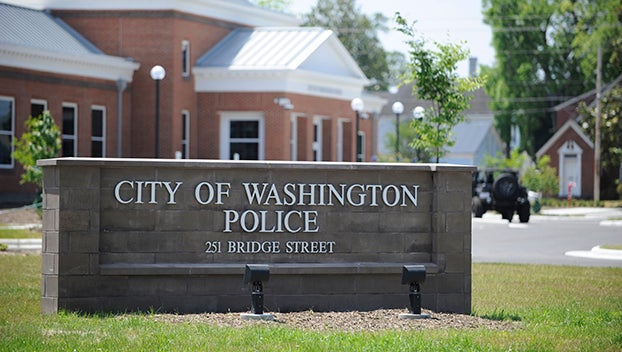Two schools, top honors
Published 1:40 am Friday, August 5, 2011
 Two Beaufort County Schools scored the top designation this year from an N.C. Department of Public Instruction report on school-performance goals, the ABCs of Public Education.
Two Beaufort County Schools scored the top designation this year from an N.C. Department of Public Instruction report on school-performance goals, the ABCs of Public Education.
The Beaufort County Early College High School and Chocowinity Primary School are two of 210 schools, or 8.4 percent of schools statewide, to earn the Honor School of Excellence Designation for the 2010-2011 school year, according to the report.
This is the second year in a row that the Beaufort County Early College High School, a learn-and-earn high school, earned the Honor School of Excellence designation — meaning 90 percent or more of its students met or exceeded growth standards and made adequate yearly progress under the federal No Child Left Behind Act as measured by end-of-grade or end-of-course testing, according to the report released Thursday.
At BCECHS, 97.3 percent of its students met or exceeded the standard, making scores at that high school on end-of-grade or end-of-course tests the best in the county, according to the report. Last year, 93.9 percent of its students met or exceeded the standards.
Chocowinity Primary School had a 90.6 percent composite score for the year. Last year, with 87.2 percent of its students meeting or exceeding growth standards, the school earned the School of Distinction designation.
“We are tremendously proud of the accomplishments of these schools,” said Beaufort County Schools Superintendent Don Phipps. “Many best practices in education are going on at each location. We seek to apply the practices to schools across our system.”
The ABCs report, issued annually by the state Department of Public Instruction, measures the academic growth of students. Schools are then recognized based on their results.
The ABCs report is based on several measures of performance. These include reading and mathematics end-of-grade tests in the third through eighth grades; science end-of-grade tests in grades five and eight and end-of-course tests in Algebra I, Algebra II, biology, civics and economics, English I, geometry, physical science and U.S. history.
The report also measures “growth” or the expectation that an individual student performs as well, or better, on end-of-grade tests as she or he did, on average, during the previous two years.
The ABCs program also includes reports on the adequate yearly progress of schools under the No Child Left Behind.
Three schools — Bath Elementary, Northside High and Southside High schools — earned the School of Distinction designation for 2010-2011, meaning that 80 percent of each school’s students met or exceeded growth standards, according to the report.
Bath Elementary School received an 83.8 percent composite score, Northside High School scored 81.8 percent and Southside High School scored 80.2 percent, according to the report. All three schools improved their scores from the 2009-2010 school year.
Educators generally agree that the ABCs report is a tool they use to get a quick snapshot of how a school district and individual schools within that district are performing. And by focusing on growth trends over time, the ABCs report also gives educators a valuable tool to track groups of students. That gives school leaders the chance to focus on problem areas within individual schools.
“We believe this measurement paints a much clearer picture regarding the progress of our schools and, most importantly, our students,” Phipps said. “A model that focuses on academic chance, or student growth, allows one to look at the student, teacher, school and system levels.”
“It’s important to look at each individual school, where they began and where they ended,” he said. “Southside High School sits at the middle of the pack when simply looking at overall numbers, but what must be noticed is this school had the highest overall growth of any school in our district. We will look at how they accomplished this and see what can be learned to benefit other schools.”
Nine of Beaufort County’s 14 public schools met or exceeded growth for the 2010-2011 school year, down from 12 of 14 schools to meet or exceed growth for the 2009-2010 year, according to the report.
A similar drop was seen in results across the state. The report shows 81.4 percent of schools meeting or exceeding growth for 2010-2011, down from last year when 88 percent of schools met or exceeded growth, according to the report.
Three schools received the School of Progress designation. These schools met or exceeded growth marks and at least 60 percent of their students scored at or above an acceptable passing grade on end-of-grade or end of course tests: P.S. Jones Middle School, Northeast Elementary School and Washington High School. Last year, eight Beaufort County schools received the School of Progress designation.
Five schools received a no-recognition designation. The following schools did not hit their growth marks but had at least 60 percent of their students scored at or above an acceptable passing grade: Beaufort County Ed Tech Center and Chocowinity Middle, John Cotten Tayloe and John Small Elementary schools. Last year, two Beaufort County schools received a no-recognition designation.
Eastern Elementary School does not have grade three or higher, so its designation is determined by the school its students subsequently attend. Since John Cotten Tayloe School received no recognition, Eastern Elementary received that designation, according to the report.
One Beaufort County school received designation as a priority school. That school, S.W. Snowden Elementary School, met its growth marks but had less than 60 percent of its student scores at or above an acceptable passing grade. In the 2009-2010 report, Snowden was listed as a priority school.
No Beaufort County school was designated as low-performing.
A total of 2,495 public schools and public charter schools were assigned a status in the ABCs of Public Education.




